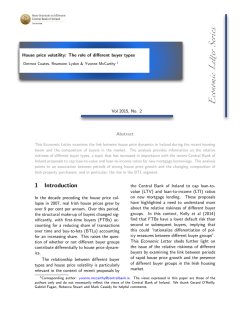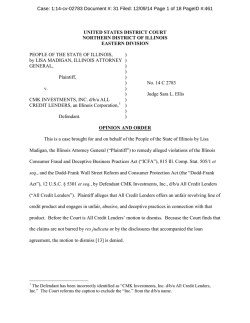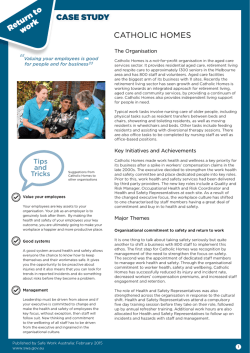
Response to DCLG consultation on "stepping onto the property ladder"
Stepping onto the property ladder - Enabling high quality starter homes for first time buyers Response by the Council of Mortgage Lenders to the Department for Communities and Local Government consultation paper Executive summary • • • • • Lenders should be seen as significant stakeholders in the delivery of this new scheme and should be involved in its design. If the proposed scheme is to operate effectively, it is likely that there will be a need for scheme rules. We would be happy to work with officials on those aspects of relevance to lenders. This would build on our work on schemes such as Help-toBuy (in all its forms) and NewBuy which have already provided many with the opportunity of home ownership. Our members are actively helping more people into home ownership. Last year CML 1 statistics suggest that 300,000 first time buyers (FTBs) took out mortgages, the highest figure since 2007. Our overall view of the scheme as outlined is that it could provide a modest addition to the flow of lower cost housing for FTBs and we would support this main objective. But we would warn against setting over-ambitious targets for the scheme at this juncture, before the attractiveness of this particular proposition has been tested on the market. Lenders have, of course, already been supportive of initiatives to help first time buyers. The NewBuy scheme ends this spring and the Help-to-Buy Mortgage Guarantee scheme has a scheduled closure date of the end of 2016. Another scheme to sit alongside Help-to-Buy Equity Loan gives FTBs another option for stepping onto the property ladder. But there are several aspects of the scheme’s detailed operation which need consideration and clarification: a) Homes under this scheme must be of a type and in locations that attract sustainable demand from FTBs and provide acceptable security for mortgage lenders b) This scheme should not be viewed in isolation but should form part of an overall strategy for home building policy c) It would be a concern if the outcome was an over supply of one type of newbuild starter homes – particularly flats – in locations which appeared intrinsically unattractive d) The composition of the sites on which the scheme operates is important. Lenders would prefer a good mix of housing and tenure on sites selected for the starter homes initiative. This will help avoid “concentration risk” where lenders feel that they are over-exposed to a particular type of borrower/property in a particular location. This is especially important in the case of newbuild where lenders have particular risk appetites. • • • 1 It is unclear what impact the proposals will have on other developments – both existing and future. This is both in terms of price for properties not within the scheme and supply of such properties. There are a number of complex valuation issues arising from the proposals. We strongly recommend that RICS are fully consulted on how these are drawn up. Lenders – and borrowers – will have to be satisfied that valuations are fair and consistent, especially in relation to comparable properties. It may be difficult to assess “open market value” for homes if there are insufficient comparables for these starter homes. The relationship of this scheme to others needs to be clarified. Whilst it might be possible to see one or more Government schemes working in conjunction to minimise the level of deposit required by the FTB, lenders still have a strong preference for borrowers to have ”skin in the game” and would expect some level of deposit to be required. Figure may include returners address North West Wing Bush House Aldwych London WC2B 4PJ telephone 0845 373 6771 fax 0845 373 6778 website www.cml.org.uk • • • • • We suggest a cascade system should be introduced allowing lenders who have taken a 2 property into possession to sell on the open market without the resale covenant restrictions after a certain period of time. 3 A standard form s106 agreement should be introduced as part of the scheme which should ensure that liability under the agreement is personal to each home owner and does not pass to successors in title or their lenders. To preserve the integrity of the scheme and prevent FTBs treating the starter homes as 4 investment vehicles, lenders favour a long term tapering period. Some of our members support the proposal that resale covenant restrictions should apply in perpetuity. Our figures show that a significant number of FTBs are 40 or over and we would question the need for any maximum age limit for scheme participants. Lenders should not be obliged to consider eligibility and any sanctions for breach should not impact on the lender or subsequent buyers. A more detailed consultation exercise on all issues not simply those on planning policy change should be undertaken. Scheme rules and any relevant guidance should be published and consulted on as soon as possible. 1. Introduction 1.1 The CML is the representative trade body for the residential mortgage lender industry that includes banks, building societies and specialist lenders. Our 124 members currently hold around 95% of the assets of the UK mortgage market. In addition to lending for home-ownership, CML members also lend to support the social housing and private rental markets. 1.2. We are pleased to respond on behalf of our members to the Department of Communities and Local Government’s consultation Stepping onto the Property Ladder: enabling high quality starter homes for first time buyers. This response has been produced following detailed discussion with members. 2. Form of response 2.1. Our membership is diverse. Where possible we have reflected members’ views and likely approaches to the scheme in this response. Different firms will have different lending policies and risk appetites for a scheme of this nature and there is no “one size fits all” response. We have therefore identified issues that will be important to our members and, where lenders’ views differ, we have set out those alternative views. 2.2. Most of the consultation questions relate to “proposed planning policy change and its implementation”. These are not areas of expertise for the CML and our members and we have not therefore answered those questions in detail. The consultation is at a high level and contains little detail; our response if therefore necessarily also at a high level. There are wider issues raised by the proposals that are not dealt with in the consultation questions and lenders, as major funders of the scheme, will need to be satisfied on these. We discuss those issues in this response. 3. The need to support first time buyers 3.1 Following the banking crisis FTBs found it increasingly difficult to access the property market. This was partly due to tighter lending criteria and the need for borrowers to provide a larger part of the equity in a property. 3.2 This position has been greatly helped by the introduction of various schemes including NewBuy 5 and Help-to-Buy Mortgage Guarantee Scheme and Help-to-Buy Equity Loan scheme. Some 15% of FTBs are already helped by the two Help-to-Buy schemes. NewBuy is coming to an end this year and 2 Provisions restricting the sale to people who have not previously been a home buyer, under forty at price determined by the scheme which is lower than market value 3 or planning conditions 4 The period during which the discounted price reverts to open market value 5 Not limited to first time buyers Help-to-Buy Mortgage Guarantee has an anticipated closure date of the end of 2016. An additional option for FTBs is therefore timely. 4. The starter homes 4.1 We believe that for the scheme to succeed it cannot be looked at in isolation and any development that takes place under the scheme should form part of an integrated housing network policy. The scale of development under this scheme should not be allowed to distort the housing market either at a national or at a local level in a negative way. 4.2 The starter homes should be designed, built and located to meet FTBs’ long term requirements. Provisioning for starter homes should be more than a planning issue. The issue is not just about creating the properties themselves but more about building integrated communities and places where young people aspire to live – places and communities where a viable market can grow, for purchase and re-sale with a mortgage. 4.3 We agree with the statement in the consultation that “any Starter home need to be of a high design quality which supports the demands of modern life”. We therefore welcome the establishment of a new Design Advisory Panel. It would be helpful to understand exactly what input that Panel will have on the starter home scheme; both in relation to specific sites or in a more general oversight role. If it is intended to include off-site construction within the scheme’s ambit, then lenders will have especial concerns over the expected life-span of the construction. 4.3 For a healthy property market development of a good mix of types of housing and tenure is desirable. The consultation paper provides for only very limited non-starter home development on starter home sites. Lenders feel that the mix should be extended. This scheme should not lead to an over supply of newbuild properties – particularly flats. We would suggest that developers should be permitted to develop other housing, including social housing, on identified sites. That housing would not benefit from the price reduction under this scheme but would give a more balanced market within local areas. 4.4 Lenders are likely to require home warranties to evidence good quality construction. 5. Buyers are likely to need to provide a deposit 5.1 When calculating the amount of the mortgage a lender is willing to lend the lender is likely to make that calculation by reference to the lower of the purchase price or the valuation. So under this 6 scheme the advance would be calculated on the lower of valuation or 80% of market value on the initial sale by the developer. Lenders are unlikely to be willing to lend 100% of the purchase price. 5.2 As the starter homes are newbuild many lenders will apply their newbuild lending policies to this calculation. Some lenders distinguish between newbuild flats and houses in their lending policies. 5.3 FTBs are therefore likely to have to find a deposit to purchase their starter home. The amount required will depend on the type of property and the individual lenders’ lending policy. For some borrowers this might involve finding a larger deposit than would be needed under the Help-to-Buy schemes. A short term tapering provision may have some impact on the level of the advance or the interest rate the lender is prepared to offer but this will depend on the individual lender. It is unclear how many FTBs will be able to obtain a mortgage to achieve the purchase price of up to 80% of the market value. It is also unclear whether FTBs would prefer this starter scheme to a property purchased with assistance under another scheme such as Help-to-Buy Equity Loan. 5.4 At present we do not think that any transaction under the starter homes scheme would come within Help-to-Buy or NewBuy. In any event lenders have indicated to us that they would be reluctant to combine two schemes under one loan. The purchase of a property is an important commitment and a FTB should have a financial stake in the transaction. This would also encourage personal financial capability. 6 See comments on valuation below 6. Availability of funding 6.1 The starter homes will be newbuild (or possibly conversions). Many lenders take a prudent approach and spread risk by limiting exposure to different types of lending. This includes lending against newbuild properties and may include a limit on the number of properties a lender is prepared to accept as security on each development. Lenders are likely to apply their standard lending policies to the scheme and some firms may therefore choose to limit their involvement in lending under this scheme or not to lend at all. 6.2 Some members feel that the level of their participation in other government schemes is disproportionately high and they may not wish to commit to this scheme to the same level of concentration. 6.3 So it is important for the scheme to operate in a way which allows as many lenders as possible to participate. They will be keen to find out if the prudential regulator has any particular view on mortgages offered under this scheme. 7. Valuation issues 7.1 The scheme relies heavily on valuation. Because of the nature of the scheme there are many complexities involved that are likely to cause issues for FTBs, lenders and developers. Some of these can be addressed by clear scheme rules and model s106 wording. Others are more dependent on the nature of the sites and the local housing market. 7.2 All these issues will mean that the Department needs to work closely with RICS. 7.3 Obtaining an accurate and reliable valuation is important in order to assess whether the discount is being properly passed onto FTBs and to calculate sale price during the tapering/perpetuity period. 7.4 Comparables – To give certainty on valuation there need to be meaningful comparables. Isolated developments on brown field sites are likely to be difficult to value. Even if comparables are available on a like for like property basis the sale restrictions imposed by the scheme and registered as a land charge are likely to make it difficult to value the starter home. 7.5 The introduction of a scheme with a discounted price in a local area may have an impact on other non discounted developments within that area. Whilst those other developments may initially act as comparables their values may fall because of the discounted starter homes. It is unclear whether the existence of starter scheme development will act as a disincentive on developers to develop other non scheme sites in the locality. 7.6 Defining open market or normal market price – The scheme requires the initial purchase price to be “a minimum of 20% below normal market price”. “Open market value” is also referred to in the consultation. Determining normal market price for starter homes in the scheme is likely to be complex. 7.7 This is because the nature of the scheme means that each starter home will not be sold in a true 7 open market. It can only be sold to eligible FTBs and for the tapering period at the applicable price reduction – so the sale of a starter home under the scheme would be to a restricted market. These resale covenants are likely to adversely affect value. The result would mean the more restrictive the covenants the greater the impact on valuation. 7.8 Appendix 10 of the Royal Institutions of Chartered Surveyors Residential Mortgage Valuation Specification states that “obligations relating to planning conditions, for instance section 106 agreements” could have “a material impact on valuation”. 7.9 So the “normal market price” for a starter home within the scheme is unlikely to match open market value of a comparable non scheme starter home. This is likely to favour the FTB. However if the scheme rules calculate value based on open market value and the impact of the resale covenants 7 Or perpetuity period is so severe that it takes the lender’s valuation to below the purchase price then the lender will base its lending on its valuation figure. This might reduce the amount that a FTB could obtain under a mortgage. 7.10 So using very basic figures if open market value is £100,000 sale price would be £80,000 and if the lender’s valuation was above £80,000 then the loan would be calculated on £80,000. If however, the scheme restrictions meant that the lender’s valuation was £75,000 the level of the loan would be calculated on £75,000 meaning that the FTB would need to find additional funds. 7.11 This continues during the tapering or perpetuity period. The FTB can only sell the property for a particular percentage of “market value”. Again the scheme rules need to clearly define this. Sellers, buyers and lenders will need to understand this calculation. They will also need to understand the nature of any sanction in the event of incorrect calculation. Government should bear in mind that obligations can pass to successors in title under s106 agreements. So buyers and lenders may be deterred from the scheme if there is any risk that additional payments may be needed in the future if a calculation is found to be incorrect. 7.12 It would therefore seemingly make sense for scheme rules to ensure all valuations under the scheme take into account the resale restrictions. However, that reverts to the problem of comparables. So government might want to discuss valuation issues under the scheme with RICS. 7.13 As a general point given problems experienced by lenders and valuers on valuation of newbuild a conservative approach to valuation is likely to be adopted for properties in the scheme. 8. Resale covenants 8.1 The scheme will include limitations on the subsequent sale of each starter home. The consultation proposes that a starter homes should only be sold to people who have not previously been a home buyer and who are below the age of 40. In addition it is proposed that there will be restrictions in planning conditions or obligations preventing the re-sale of the properties at market 8 value for a [five to fifteen] year period . We assume this period is calculated from the date of the first sale to the first FTB? 8.2 Many lenders already lend on schemes that include such covenants – often in rural areas or for key workers. However, we are not aware of this being carried out in significant volumes and we believe DCLG’s estimate of 100,000 starter homes is considerably higher than the levels of this type of lending currently being undertaken. Firms’ appetite for this scheme may therefore vary. 8.3 We are unclear whether the FTB under 40 restrictions are intended to be simply for the very first FTB or for all buyers of the starter homes. We are also unclear whether these are to apply in perpetuity or for the tapering period. These points will need to be clarified in scheme rules. 8.4 To preserve the nature of the scheme some of our members believe that the resale covenants should apply in perpetuity. This would mean that the starter homes would be available for FTBs for many generations to come. It would also prevent FTBs making a significant profit once the tapering period ended. On that basis those lenders propose that the percentage of market value at which a starter home can be sold will be a fixed percentage and will apply in perpetuity. This would be similar to a shared equity scheme. Logic would dictate that the other two resale covenants should, if this proposal is adopted, also apply in perpetuity. 8.5 Other lenders favour the tapering period. Many prefer a longer tapering period – again to preserve the nature of the scheme and to help ensure that the scheme helps FTBs onto the property ladder rather than providing them with a relatively short term investment vehicle. 9. Mortgagee sales and resale covenants 9.1 We understand the need to preserve the nature of the scheme and if possible ensure that eligibility requirements are met. But restrictions requiring sale to a limited market, in this case FTBs 8 “the tapering period” under 40, are not looked on favourably by lenders. If a lender has to sell the property as a mortgagee it is obliged to sell at the best price reasonably obtainable for the property. If only a limited number of people are able to buy the property and no suitable buyer is available, the lender will not be able to sell and the borrower’s debt will continue to accrue. 9.2 We would therefore suggest that a cascade system is introduced. This would require the lender initially to try to sell to a FTB under 40 years of age. If that was unsuccessful within a specified period 9 then the lender should be allowed to sell to any willing buyer. If eligibility criteria are more restrictive then the need for a cascade system will become even more important to lenders. 9.3 This should not prejudice the scheme as the resale covenants will bind the lender’s buyer. 9.4 The resale covenant relating to price is more complicated. Whilst it is hard to see how a property which has been marketed at a reduced price under the scheme should sell more readily at open 10 market price there may be circumstances where this is the case. Some of our members would therefore want a cascade system to apply to this resale covenant as well. Others do not want this as it may encourage gaming by borrowers. 10. Eligibility 10.1 The two main eligibility requirements for buyers are “people who have not previously been a home buyer” who are under 40 at the time of purchase. 10.2 We think the scheme rules need to establish who assesses eligibility. For the initial FTB we believe this should be established by the developer. Declarations of eligibility could be included in the register of interest. It may be that in subsequent sales there needs to be some sort of self certification system established. It is important that lenders do not have to establish eligibility except where selling as mortgagee when the sale restrictions apply. 10.3 The scheme rules will also need to consider what happens if after completion it is established that the buyer/ borrower was ineligible. Part of the lending process requires lenders to assess “affordability” prior to lending. A sudden additional burden such as a fine or an obligation to repay the difference between the purchase price and market value is likely to have a significant impact on the borrower’s ability to meet its mortgage obligations. Lenders need to have confidence that their position is not prejudiced where error or fraud may have occurred. 10.4 Any attempt to recover the money should not prejudice the lender’s position as first legal charge holder and care needs to be applied to the wording used in any planning obligations such as a section 106 agreement so that subsequent purchasers and lenders are not responsible for any breach by a predecessor in title. 10.5 Age – we welcome the recognition that FTBs are coming to the market at a later stage in life. However, according to the Regulated Mortgage Survey 12% of recent FTBs are over 40 and roughly half of them are between 41 and 45. Is there therefore a need for a maximum age limit? 10.6 Previous home buyer – Whilst it is relatively easy to establish age it is more difficult to establish whether or not someone has previously been a home buyer. DCLG might want to consider using the definition of first time buyer used by HMRC for stamp duty land tax. HMRC could use its own records to establish whether someone had previously been a home buyer. However, for other organisations such as lenders and developers this is more complicated. There is no specific search that can be carried out. Credit reference agency searches may give some indication as to previous address but not necessarily tenure. 10.7 As the consultation states that the restriction on home buyers refers to “all individuals in the household purchasing the property” this process may need to be undertaken in relation to more than one individual which increases the risk of error. 9 For example a lower age limit or income restrictions Particularly when the buyer will be subject to the resale covenants 10 10.8 The definition excludes potential buyers who have previously purchased a property, but for example because of relationship breakdown, need to return to the housing market. Is it fair to exclude such buyers? 10.9 Change of circumstance – Scheme rules will presumably need to deal with changes in circumstance. For instance if the buyer at the outset has never previously been a home owner but then enters into a relationship with a former home owner and wants to add that person to the title – what would be the position? 11. Planning 11.1 We assume that the Written Ministerial Statement will require Local Authorities to accept sites for starter schemes unless there are “overriding considerations in relation to health, safety or infrastructure that cannot be mitigated”.. 11.2 Lenders are keen that local authorities should not be able to hinder the implementation of the scheme and would welcome this. 11.3 We are not clear what involvement the planning authorities would have otherwise. Is it the intention that other than deciding whether there are any overriding considerations the local planning authorities will be involved with the development in the usual way? 11.4 How is infrastructure to be funded? The scheme’s proposals remove a source of funding for infrastructure from local authorities. Given the nature of the sites it seems probable to us that infrastructure will be needed. How is this to be addressed? 11.5 Who assesses how the savings made by developers in planning costs are passed on to FTBs? We assume that this will be covered in scheme rules. 11.6 We think that a standard form or model form section 106 agreement/set of planning conditions would be a sensible approach. This would assist the conveyancing process, developers and lenders. Experience with shared ownership schemes has shown that uniformity of such documentation is helpful to all parties. If the approach followed by government is to include the resale covenants in a s106 agreement then appropriate drafting in that agreement should ensure that liability under the agreement does not bind successors in title of a FTB. 11.7 There needs to be a clear procedure for identifying properties that come within the Starter Home Scheme. This will assist the lending and conveyancing process. This could presumably be as a local land charge. 11.8 As with Help-to-Buy the Starter Home scheme will need to be treated as an incentive and the CML’s disclosure of incentives form will be amended to take this into account. 11.9 Given the nature of the sites it will important to ensure there is no contamination of land. 12. Standard form scheme documentation needed 12.1 The consultation refers to a Written Ministerial Statement and we understand that guidance for Local Authorities may also be published. We do not think that a scheme of this type can be established without clear standard form documentation. The documentation should set out the scheme rules and the requirements on the Local Authority, the developer and FTBs. In particular, there must be clear rules and some form of “policing” relating to the sale price of each starter home. Consultation questions Q1: Do you agree in principle with the idea of a new national Starter Homes exception site planning policy to deliver more low cost homes for first time buyers? Mortgage lenders support measures which deliver affordable ways for people to access home ownership. If the planning policy delivers quality housing that meets FTB demand then these proposals should provide a modest additional flow of lower cost housing for first time buyers. As identified above there are a number of complexities involved in the proposals. Key unknowns are how many households would be attracted to the scheme and how financially able such buyers are to obtain a mortgage to achieve the purchase price. The CML and is members are willing to engage with government and key stakeholders on development of the detail required for implementation of the scheme. Q2: Do you agree that the Starter Homes exception site policy should focus solely on commercial and industrial brownfield land which has not been identified for housing? It seems sensible to focus on brownfield land which has not been identified for housing already. It will be necessary, however, to ensure sites are identified which could be sufficiently attractive in terms of neighbourhood, community and infrastructure/ transport links, including broadband and mobile coverage, for younger FTBs to want to live there and set-up home. It will also be necessary to ensure that site remediation costs do not significantly challenge or undermine the financial viability of the development. Q3: Do you agree that the types of land most suitable for starter homes will be under utilised or non-viable sites currently (or formerly) in commercial or industrial use? See our answer to 3 and our general comments. We are not land buying experts but it is important that development meets demand and that starter homes are built in locations where FTBs want to live and demand will be maintained. Q4: Do you consider it necessary to avoid starter homes developments in isolated location or where there would be conflicts with key protections in the National Policy Framework? We see no reason why starter home developments should not be in isolated locations if there is likely to be demand from FTBs. We agree that sites where infrastructure is lacking are unlikely to be suitable. Q5: Do you agree that the starter homes exception site policy should allow at the planning authority’s discretion a small proportion of market homes to be included when they are necessary for the financial viability of the Starter Homes site? Yes and we believe this should be extended to allow developers to build other housing, including social housing, on starter home sites. That housing would not benefit from the price reduction under this scheme but would give a more balanced market within local areas. It will be necessary for the credibility of the starter homes scheme in the public mind to ensure that starter homes are not used as a means to avoid some planning requirements. Q6: Do you agree starter homes secured through the Starter Homes exception site policy should only be offered for sale or occupation to young first time buyers? No. We welcome the recognition that FTBs are coming to the market at a later stage in life. However, according to the Regulated Mortgage Survey 12% of recent FTBs are over 40 of which roughly half are between 41 and 45. We cannot therefore see the need for a maximum age limit. Q7: Do you think there are sufficient existing mechanisms in place to police this policy? We cannot see any proposal in the consultation for policing the scheme. There are no proposals for sanctions in the event of breach included in the consultation. The lack of clear rules and standard form documentation seems to us a major flaw in the proposals and may well delay the conveyancing, valuation and lending process. We also have concerns that existing mechanisms such as the HCA’s network of HomeBuy agents might need additional resources and training to effectively police this policy. In addition, restrictions on open-market disposal are likely to present a barrier to mortgage ability if framed too tightly or if there is a delay in the operation of any cascade to expose the property to full-market sale on disposal, including in repossession scenarios. Q8: What is the most appropriate length for a restriction on the sale of a starter home at open market value? How should the sliding scale be set? To preserve the nature of the scheme some of our members believe that these resale covenants should apply in perpetuity. This would mean that the starter homes would be available for FTBs for many generations to come. It would also prevent FTBs making a significant profit once the tapering period ended. On that basis those lenders propose that the percentage of market value at which a starter home can be sold will be a fixed percentage and will apply in perpetuity. This would be similar to a shared equity scheme. Other lenders favour the tapering period. Many prefer a longer tapering period – again to preserve the nature of the scheme and to help ensure that the scheme helps FTBs onto the property ladder rather than providing them with a relatively short term investment vehicle. We cannot see any provision for claw back or any obligation on the FTB to repay the discount. Is that the intention? If there is an obligation of this type we would need this clarified and lenders may have regulatory issues on affordability to consider. Q9: Do you agree that guidance should make clear it is inappropriate for starter homes exception site projects to be subject to s106 contributions for affordable housing and tariffs? Guidance on this point would be welcome as it could help to clarify the government’s position on affordable housing as essential infrastructure, in the context of CIL and s106 contributions. The guidance should make explicit the point that s106 contributions can still be sought for site-specific infrastructure improvements necessary for the practical viability of the project. Q10: Do you agree that starter homes exception site projects should be exempt from the payment of the Community Infrastructure Levy? This seems sensible, although the issue is really one for Local Authorities to comment on. Q11: Do you have any views on how this register should work and the information it should contain? The scheme needs to consider how eligibility is assessed. For the initial FTB the register could act as a self certifying declaration of eligibility which could be relied on by developers and lenders. Sufficient funding and resources will have to be put in place to ensure that the register is capable of operating in a sufficiently dynamic way which can keep pace with the real-time highly connected and constantly changing lives of younger would-be first-time buyers. The register would have to have a strong identity on all major online and mobile platforms. There would need to be clarity about who owns and operates the register and how the data it contains could be used and by whom. There could be a strong potential for registrants’ data to be misused for marketing of other products and services, and safeguards would be needed to counter this and provide the required protection for individuals on the register. Q12: What kind of vanguard programme would be most helpful to support the roll out of starter homes? We remain to be convinced that best practice can be readily or quickly identified given the variability of local markets and needs, and geographical considerations and differences. What might be best practice in one area or site might not suit another. We believe there should be further sector input to inform and shape the vanguard programme to ensure it has the best chance of success and, crucially, that the homes which are built are mortgageable both at the time of initial sale and into the future. The vanguard programme should be able to demonstrate lender appetite for the product. Contact If you have any questions or comments on this response please contact Samantha Barnett ([email protected])
© Copyright 2025





